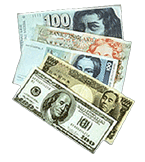Russians lose millions in currency exchange transactions
The US dollar is becoming stronger in Russia
Russians buy dollars and euro at the highest price, right before the moment when the rates of both currencies will inevitably drop. At that, Russians lose millions of rubles. The Central Bank's statistics reveals that the peak price of currency coincides with the peak of people's demand for this currency. The current period is a period of sudden fluctuations in the price of currency; financiers know how to make use of this period. Their tactic at that is absolutely different from the tactic of ordinary buyers of currency.
Within the three weeks since March 12, the US dollar has gone about 50 kopecks up to 27.94 rubles per dollar. Within the same period, the euro has gone down in price for more than 1 ruble to 35.82 rubles per euro. Those who hold cash currency feel these fluctuations particularly acutely.
Experts know that currency yields dividends when purchased at the moment when its price drops and sold when the price for currency soars. The Izvestia newspaper states that it is more difficult from the psychological point of view to sell currency when it goes up in price and sell the currency that becomes cheaper. This is the reason why the population follows quite an opposite tactic. In October 2004, when the dollar price started falling down and the euro went up, the demand for euro increased by 5 per cent while the demand for dollar dropped by 2 per cent.
In November 2004, dollar dropped to 28.2 rubles per dollar and euro went up to 37.4 rubles per euro. At that, the demand for US dollars dropped by 14 per cent and the demand for euro increased by 55 per cent and made up $1 billion. The illogical tactic of the Russian population reached its peak in December when Russians bought euros at the price of 37.8 rubles per euro to the sum of $1.5 billion, which was a record level since the European currency was introduced in Russia. In January 2005, when the US dollar went up, the situation was quite different.
Analyst Igor Lavushchenko with the Prospect Investment Group thinks this tactic is a typical mistake that mass investors commit; they often give way to panic. “Professionals know how to make use of this panicky atmosphere. Professional market makers win part of money that the population loses at that,” Igor Lavushchenko says.
The analyst recommends to hold savings in various currencies: 70 per cent and more in rubles and the rest in dollars and euro. The share of any currency must be increased at a reasonable moment. As of today, it is the dollar that has registered growth, however experts state that the dollar rate will soon drop. Igor Lavushchenko is sure it is better to keep savings in dollars, because in the nearest time the American currency will go one per cent up. Head of the Bank of Moscow analytical department Kirill Tremasov supports the opinion. He adds that against the background of the USA's increasing rates, the euro to dollar rate may decrease in Russia. As a result, the dollar rate may go up to 28.2 – 28.3 rubles per dollar. As soon as the US dollar reaches the showing, it makes sense selling it.
Kirill Tremasov predicts that then the situation will change. “And the dollar-to-ruble rate will be fluctuating about 28 rubles per dollar till end of the year,” the expert thinks. Head of the BIN-bank conversion department Mikhail Parasenko is sure that the dollar will inevitably go down as soon as its rate increases by 5-10 kopecks. As for the European currency, it may go up at least 50 kopecks more. So, it makes sense not to sell euro now.
Subscribe to Pravda.Ru Telegram channel, Facebook, RSS!





